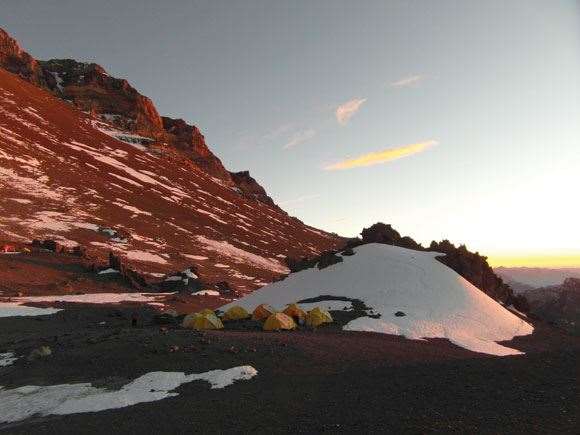Climbing a high mountain produces scant adrenaline and offers little in the way of thrills. Instead it’s all about discomfort;
 photos by AARON SCOTT
photos by AARON SCOTTClimbing a high mountain produces scant adrenaline and offers little in the way of thrills. Instead it’s all about discomfort;
Maybe it’s the spectre of rock falls or frostbitten digits or a gasping, frozen death, but most people figure high-altitude mountain climbing to be a pursuit peopled by wild-haired adrenaline junkies and wide-eyed thrill seekers. An extreme sport, right? In fact, it’s anything but. Climbing a high mountain produces scant adrenaline and offers little in the way of thrills. Instead it’s all about discomfort; all about shouldering a load of discomfort that grows exponentially heavier the higher you go. I can say this with some authority because recently I sought to climb Argentina’s Cerro Aconcagua, at 6962m the highest mountain in the Americas, indeed the highest peak in the world outside the Himalayas. And, believe me, it got very uncomfortable.
Aconcagua may not have the heft of the great Himalayan peaks, or the elegance of the famed European Alps, or even the mystique of the fabled Kilimanjaro, but this is a serious mountain. Sitting at the heart of the high Andes, straddling the Argentinean-Chilean border, on a latitude roughly analogous to Sydney, Aconcagua is a vast slab of prehistoric seafloor that was thrust into the troposphere when the Nazca Plate crashed into the South American Plate 60-odd million years ago. It’s a monstrous lump of uplifted rock whose appearance is largely dictated by the horrid Andean winds. The southern face of the mountain, which bears the brunt of the Antarctic winds that roar across the southern reaches of the Pacific before raking the Patagonian glaciers, is covered by shimmering pillows of snow and overhanging walls of bluish ice. It is, quite frankly, a terrifying sight. Climbing up this face is a fiendishly difficult task, requiring ice axes and ropes and all kinds of specialised alpine skills I don’t possess.
The western face of the mountain, by contrast, opens onto the warmer winds that tumble across the Pacific, and is almost completely free of snow and ice. This face presents great sweeps of brown scree broken by immense, pillared walls of sandstone. It looks like the monumental backdrop to a spaghetti western. In the evenings it glows a deep crimson against the setting sun. The guides call this effect “Aconcagua on fire” but to my eyes it looks more like the mountain is covered in blood. Climbing this side of the mountain is, in a technical sense, a straightforward affair. There’s no call for axes or ropes or an intricate understanding of crampons. All that’s needed, according to Aconcagua Expeditions, the company I book my expedition through, is adequate gear, a high level of physical fitness, and a good run of weather. This is the side of the mountain I plan to tackle.
I meet the other members of my expedition in the air-conditioned lobby of a three-star hotel in the Argentinean wine capital, Mendoza. There are four guides and 13 paying customers. The four guides, headed by a long-haired 28-year-old named Martin, are all local Mendocinos and all look furiously fit. They’ll lead four to five expeditions each season, which means that a greenhorn like Martin has still been to the summit around 30 times. He examines the paying customers with a wry smile. No doubt we’re an eclectic bunch. There are three women and ten men, the oldest of whom is 68, the youngest 23. There’s a Spaniard, a Swiss, a Swede, a Chilean, a Colombian, a German, an Indian, an Englishman. There’s Brad, a bearded Kiwi, who admits he’s already stopped showering in preparation for the mountain. There’s Leandro, a grinning Argentinean, who proudly announces his wife is currently seven months pregnant. And there’s Ben, my designated tent mate, an Essendon fan with a penchant for jiu-jitsu, kung fu and amateur boxing.
We all shake hands awkwardly and scratch about for conversation. “So, uh, what other mountains have you climbed?” Many of us have climbed Kilimanjaro, a few have climbed Mont Blanc, several have done the Inca Trail. None of us have gone above 6000m. I find myself looking around, examining the faces, scanning the bodies, trying to work out who’ll be the first to drop. Although percentage figures are sketchy (most guiding companies remain coy on their summit rates), the majority of climbers don’t reach the top. Shifting eyes suggest others are making their own quiet assessments. I wonder if anyone’s tagged me as the first to fall ...
Related Articles

Socceroos coach says Argentina can only 'play two ways'

Argentina coach on 'inferior' Socceroos: 'I don't fully agree'













